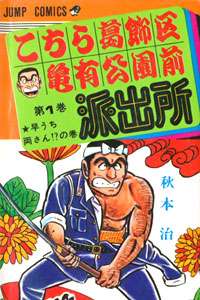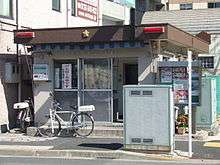Kochira Katsushika-ku Kameari Kōen-mae Hashutsujo
| Kochira Katsushika-ku Kameari Kōen Mae Hashutsujo | |
 Cover of the first Kochira Katsushika-ku Kameari Kōen-mae Hashutsujo manga volume | |
| こちら葛飾区亀有公園前派出所 (Kochira Katsushika-ku Kameari Kōen-mae Hashutsujo) | |
|---|---|
| Genre | Comedy, police |
| Manga | |
| Written by | Osamu Akimoto |
| Published by | Shueisha |
| Demographic | Shōnen |
| Imprint | Jump Comics |
| Magazine |
Weekly Shōnen Jump Kochikame Maitsuki Taise Rekushon Gatsu Kyoku Chō Selection Konbini Tokushū Genteiban Getsurei Tokusen Choice! Gatsu Ichi Gokujō Choice!! Kochikame Gold Kochikame Hit Parade!! Kyokusen Tsuāzu!! |
| Original run | September 21, 1976[1] – September 17, 2016 |
| Volumes | 200 |
| Anime television series | |
| Directed by |
Tetsuo Yasumi Noboru Misawa Shinji Takamatsu Norihiro Takamoto Akira Shigino |
| Music by | Ryo Yonemitsu, Toshihiko Sahashi |
| Studio | Studio Gallop |
| Network | Fuji TV |
| Original run | June 16, 1996 – December 19, 2004 |
| Episodes | 373 + 9 specials |
| Anime film | |
| Kochira Katsushika-ku Kameari Kōen-mae Hashutsujo The Movie | |
| Directed by | Shinji Takamatsu |
| Written by | Toshimichi Okawa |
| Studio | Studio Gallop |
| Released | December 23, 1999 |
| Runtime | 95 minutes |
| Anime film | |
| Kochira Katsushika-ku Kameari Kōen-mae Hashutsujo The Movie 2: UFO Shūrai! Tornado Daisakusen!! | |
| Directed by | Shinji Takamatsu |
| Written by | Shinji Takamatsu, Toshimichi Okawa |
| Studio | Studio Gallop |
| Released | December 20, 2003 |
| Runtime | 109 minutes |
| Anime television series | |
| Kochira Katsushika-ku Kameari Kōen-mae Hashutsujo The Final: Kankichi Ryotsu's Last Day | |
| Directed by | Akira Shigeno |
| Produced by | Tomoko Takahashi |
| Written by | Takashi Yamada |
| Studio | Studio Gallop |
| Network | Fuji TV |
| Original run | September 18, 2016 |
| Episodes | 1 |
Kochira Katsushika-ku Kameari Kōen Mae Hashutsujo (こちら葛飾区亀有公園前派出所, lit. "This is the police station in front of Kameari Park in Katsushika Ward"), often shortened to Kochikame (こち亀), is a Japanese comedy manga series written and illustrated by Osamu Akimoto. It takes place in the present day, in and around a neighborhood police station (kōban) in the downtown part of Tokyo, and revolves around the misadventures of middle-aged cop Kankichi Ryotsu.
It was continuously serialized in Weekly Shōnen Jump for 40 years, from September 1976 to September 2016. Its 1,960 chapters were collected into 200 tankōbon volumes, making it the manga series with the highest number of volumes.[2][3] The manga has been adapted into a television anime series, produced by Studio Gallop and broadcast across Japan by Fuji Television, two theatrical animated films, two live-action movies, several stage adaptations, and a live-action television series. As of February 2012, the series had sold over 155 million copies, making Kochikame one of the best-selling manga series in history. In 2005, TV Asahi named the anime number 36 on its list of the Top 100 Anime. The series was awarded a Guinness World Record for "Most volumes published for a single manga series."
Plot
The typical Kochikame plot involves Kankichi "Ryo-san" Ryotsu coming up with a money-making scheme by inventing a new gadget or capitalizing on a fad, achieving great success, calling on Keiichi Nakagawa's help as things turn sour, and finally losing it all as the fad runs out of steam or out of control. While the plots are gag-driven, much of the humor comes from the combination of mundane characters with those that are bizarrely out of place; such as Nakagawa who has wealth and Ai Asato who has appeal. What they have in common is everyone's lack of actual police work, most of which is never explained or rationalized in the slightest. (It is explained in Jump that Ryo-san is one of the best officers at catching criminals.) Nakagawa and Reiko Akimoto have special licenses (such as for wearing personal clothes instead of uniforms to work) from police headquarters because of their skills in linguistics.[4]
The plot consistently evolved with the times and most of the main characters do not really age, despite the fact that the series started in the 1970s and is later clearly set in the 2010s. However, some characters do age, like the grandchild of Buchao, who was a baby in the early books, but is now close to junior high, which the author has self-mocked in a few "look back" episodes.
Kochikame has a broad audience, ranging from adolescent boys to middle-aged salarymen. Much like Homer Simpson, Ryo-san's antics appeal to children who can laugh at an old buffoon, and to men fearing that they are becoming old buffoons themselves—and also because it often subtly mocks the latest fads and trends. The stories are generally innocent in content, and what little violence appears is comical, while the occasional risqué subjects are included strictly for laughs rather than to titillate. In another parallel to The Simpsons, Kochikame's immense popularity has led to guest appearances in the strip by real-life Japanese celebrities such as Tetsuya Komuro.
For creator Osamu Akimoto, Kochikame is an homage to the working-class people and districts of old Tokyo, and most episodes open with an elaborate full-page illustration of a Shitamachi (down-town) street scene, typically with old wooden buildings and boys playing in the streets.
Media
Manga
Written and illustrated by Osamu Akimoto, Kochira Katsushika-ku Kameari Kōen Mae Hashutsujo was continuously serialized in Weekly Shōnen Jump since September 21, 1976. Akimoto debuted the series under the pen name of "Tatsuhiko Yamadome", but changed to using his real name in 1978, when it reached its 100th chapter. Periodically the chapters were collected into tankōbon volumes by publisher Shueisha, the first released on July 9, 1977.[5] The series ended on September 17, 2016 in the 42nd issue of the year, in commemoration of Kochikame's 40th anniversary. Its 200th and final tankōbon volume was published on the same day.[6] Shueisha will reprint the issue that included the final chapter on December 31, 2016, marking the first time a Weekly Shōnen Jump issue has ever been reprinted.[7] In 2017, a sequel manga created by Akimoto will run in Ultra Jump. Titled Ii Yu Da Ne!, it will be set in a bath house next to a police station in Shitamachi, Tokyo.[8]
Anime
A television anime adaptation of Kochikame began airing on Fuji Television on June 16, 1996. Produced by Studio Gallop, it ran for eight years and 373 episodes before ending on December 19, 2004. On September 18, 2016, an hour-long special by Studio Gallop will air on Fuji TV for the manga's 40th anniversary. It will feature several voice actors reprising their roles from the previous series, as well as director Akira Shigeno.[9]
Studio Gallop also produced two animated theatrical films, released on December 23, 1999 and December 20, 2003 respectively.
Live-action
Kochikame has also had live-action film, a TV drama and stage adaptations. The movie was directed by Kazuhiko Yamaguchi, starred Mitsuo Senda as Ryo-san and was released in 1977.[10] A live-action TV series starring Katori Shingo as Ryo-san began airing on TBS on August 1, 2009.[11] A second live-action movie, based on this TV series and titled Kochikame - The Movie: Save The Kachidiki Bridge!, opened in Japan on August 6, 2011.[10] Another play adaptation opened in September 2016 for the series' 40th anniversary and, like the others, it was directed, written by and stars Lasar Ishii as Ryo-san, who is also the voice actor for the character in anime adaptations.[12]
Other media
As part of its 40th anniversary celebration, the series received a 6-part crossover anthology novel with various characters from other series on September 17, 2016. Titled Vs. Kochira Katsushika-ku Kameari Kōen-mae Hashutsujo: Novelization Anthology (VS.こち亀 こちら葛飾区亀有公園前派出所ノベライズアンソロジー), the other series are Girls und Panzer, Osomatsu-san, Haruchika, Cheer Boys!!, Sorcerous Stabber Orphen and Nazutoki wa Dinner no Ato de.[13]
Ryotsu appears playable in the Weekly Shōnen Jump crossover fighting video games Jump Super Stars, Jump Ultimate Stars and J-Stars Victory VS. Other characters from the series appear in a non-playable capacity. J-Stars Victory VS.'s North American and European release (as J-Stars Victory VS.+) marks the first official release of Kochira Katsushika-ku Kameari Kōen-mae Hashutsujo material in English-speaking territories.
In addition, various toys and collectibles have been created, including some items that first appeared in the manga as creations of Ryo-san.
Real-life Kochikame

Kameari Koen is an actual park in Tokyo's Katsushika ward. The police station is fictional, but it is modeled after a real one located on the north side of Kameari railway station. The manga has brought considerable fame to the neighborhood, and it draws sightseers from all over Japan to a (usually vacant) station in a nondescript residential neighborhood. There is only a vacant lot where the police station is actually supposed to be located.
In February 2006, two life-size bronze statues of Ryo-san were erected at the north and south gates of Kameari Station. There is currently a trail of 14 statues in the area.[14]
30th anniversary
In commemoration of the 30th anniversary of Kochira Katsushika-ku Kameari Kōen Mae Hashutsujo's serialization, several special events were held. Separate one-shots of the series were published in thirteen different Shueisha magazines between August and October 2006.[15]
Reception
As of February 2012, Kochira Katsushika-ku Kameari Kōen-mae Hashutsujo had sold over 155 million copies,[16] making it one of the best-selling manga series in history. Upon ending in 2016, the series was awarded a Guinness World Record for "Most volumes published for a single manga series" with 200.[17]
In 2005, TV Asahi named the anime number 36 on its list of the Top 100 Anime.[18]
See also
- Kōban, neighborhood police stations in Japan
References
- ↑ http://www.j-kochikame.com/arigatou/
- ↑ "Thirty Years of Gags". Web-Japan.org. 2006-09-04. Retrieved 2009-07-07.
- ↑ "Celebrating its 30th Anniversary, Interview with the Artist of Kochi-Kame". Comipress. 2006-09-19. Retrieved 2009-07-07.
- ↑ McCarthy, Jonathan Clements, Helen (2007). The anime encyclopedia : a guide to Japanese animation since 1917 (Rev. & expanded ed.). Berkeley, Calif.: Stone Bridge Press. p. 867. ISBN 1933330104.
- ↑ こちら葛飾区亀有公園前派出所 1 (in Japanese). Shueisha. Archived from the original on 2011-07-06. Retrieved 2014-03-13.
- ↑ "Osamu Akimoto's Kochikame Manga Ends on September 17 After 40 Years of Serialization". Anime News Network. 2016-09-03. Retrieved 2016-09-03.
- ↑ "Weekly Shonen Jump Gets First Ever Reprint Thanks to KochiKame". Anime News Network. 2016-11-06. Retrieved 2016-11-06.
- ↑ "KochiKame's Osamu Akimoto Publishes 4 New Manga in 2017". Anime News Network. 2016-09-15. Retrieved 2016-09-15.
- ↑ "KochiKame TV Anime Is 1-Hour Special Premiering September 18". Anime News Network. 2016-08-09. Retrieved 2016-08-09.
- 1 2 "Manga-Based Live-Action Kochikame Comedy Gets Film". Anime News Network. 2010-08-08. Retrieved 2014-03-13.
- ↑ "Kochikame, Shōjo Manga Get Live-Action TV Dramas". Anime News Network. 2009-05-28. Retrieved 2014-03-13.
- ↑ ""KochiKame" Stage Play Presents an Explosive Main Visual". Crunchyroll. 2016-05-23. Retrieved 2016-09-15.
- ↑ "Kochikame Manga Gets Novel Crossovers With Girls Und Panzer, Cheer Boys!, Mr. Osomatsu". Anime News Network. 2016-07-27. Retrieved 2016-09-15.
- ↑ "Local communities erect manga/anime statues with tourists in mind". Asahi Shimbun. January 19, 2015. Retrieved January 29, 2015.
- ↑ "Kochikame Comedy Manga to Appear in 13 Magazines". Anime News Network. 2011-07-06. Retrieved 2014-03-13.
- ↑ "Top 10 Shonen Jump Manga by All-Time Volume Sales". Anime News Network. 2012-10-23. Retrieved 2012-12-20.
- ↑ "Kochikame Earns Guinness World Record For Most Volumes Published For Single Manga Series". Anime News Network. September 11, 2016. Retrieved September 11, 2016.
- ↑ "TV Asahi Top 100 Anime". Anime News Network. 2005-09-27. Retrieved 2014-03-13.
External links
- Official website
- Fuji TV Kochikame website
- TBS Kochikame website
- Kochira Katsushika-ku Kamearikouen-mae Hashutsujo (manga) at Anime News Network's encyclopedia